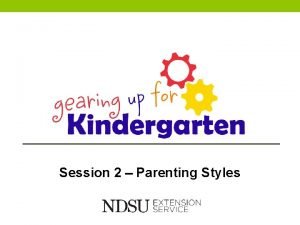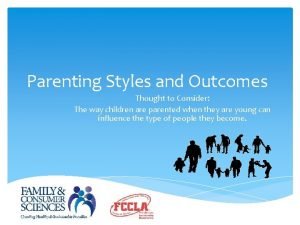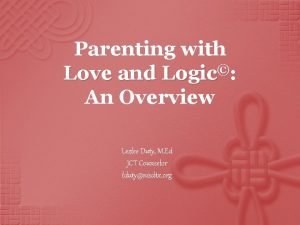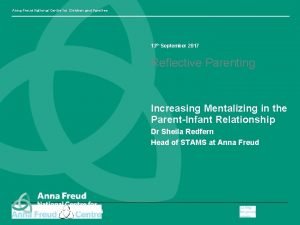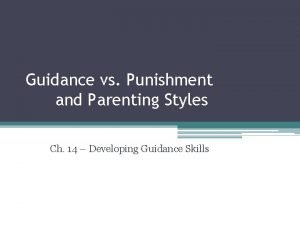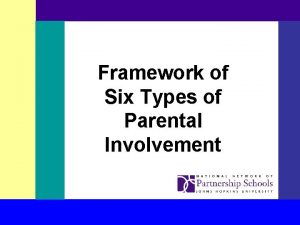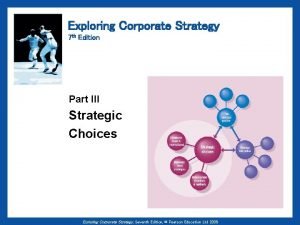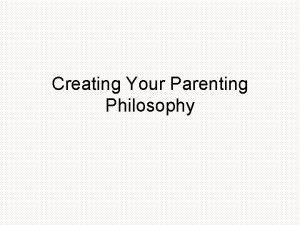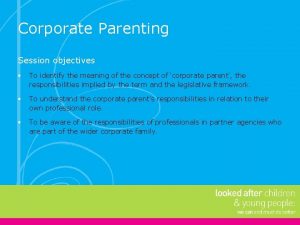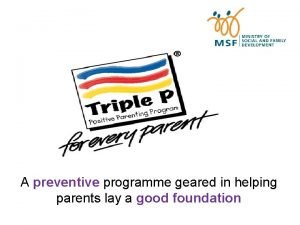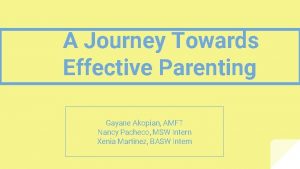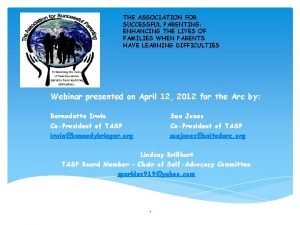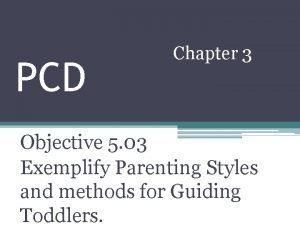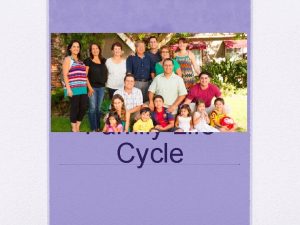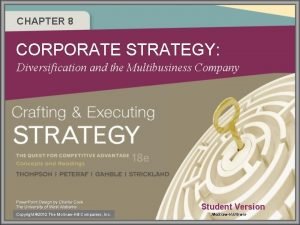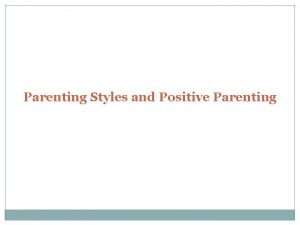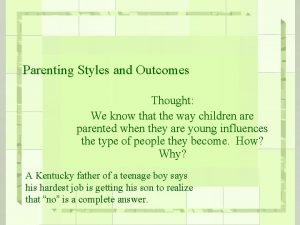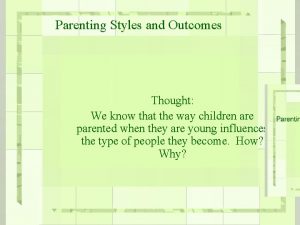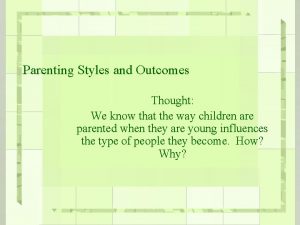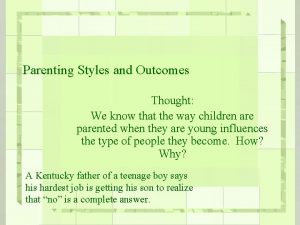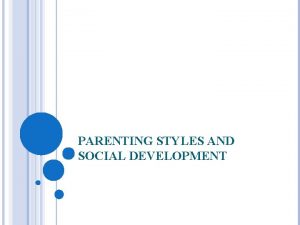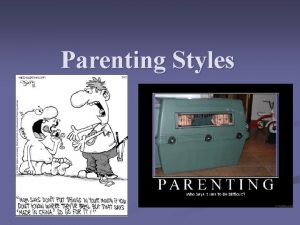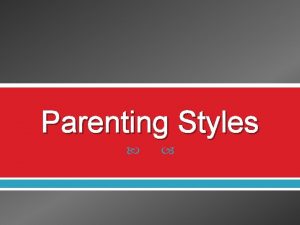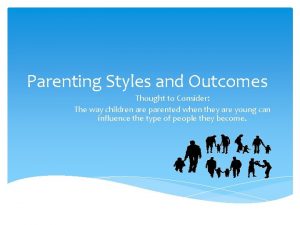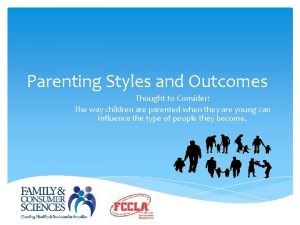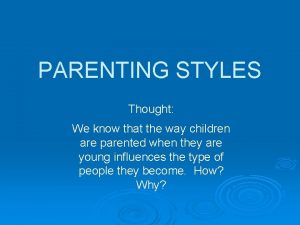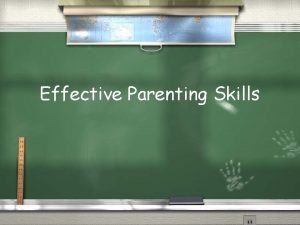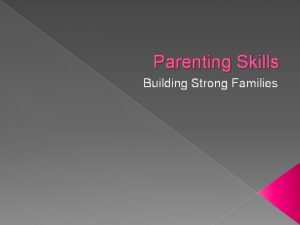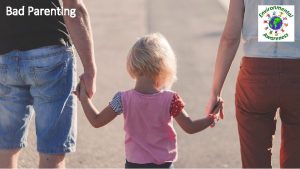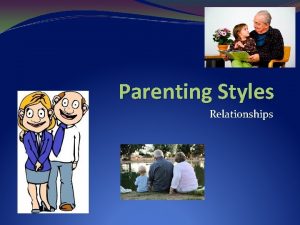Parenting Styles and Outcomes Thought We know that




































- Slides: 36

Parenting Styles and Outcomes Thought: We know that the way children are parented when they are young influences the type of people they become. How? Why?


Impact of Parents How we are parented affects all other aspects of social development We pick better friends with better parenting We are less impacted by negative media with better parenting

Match 1. Responsive to children's’ needs. 2. Indifferent to children, ignore them 3. Reject their children 4. Critical, derogatory, dissatisfied with their children. 5. Warm, understanding and accepting. A. Hostile and antisocial B. Poor self-control, difficulty with social interactions when teenagers. C. Compliant with parent’s wishes D. Happy and friendly E. Dissatisfied with themselves.

Matching Key 1. Responsive to children's’ needs. 2. Indifferent to children, ignore them 3. Reject their children 4. Critical, derogatory, dissatisfied with their children. 5. Warm, understanding and accepting. A. Hostile and antisocial B. Poor self-control, difficulty with social interactions when teenagers. C. Compliant with parent’s wishes D. Happy and friendly E. Dissatisfied with themselves.

Types of Parenting Styles and Outcomes Most parents can be classified into four main types by the style in which they guide their children.

1. Authoritarian: Limits without Freedom. Parents’ word is law, parents have absolute control. Misconduct is punished Affection and praise are rarely given Parents try to control children’s behavior and attitudes They value unquestioned obedience Children are told what to do, how to do it, and where to do it, and when to do it.

Outcomes of Authoritarian Style • Obedient • Distrustful • Discontent • Withdrawn • Unhappy • Hostile • Not High Achievers • Often Rebel Control from parent creates a dependent child Children can’t make their own decisions about behavior

2. Permissive: Freedom without limits. Parents allow their children to do their own thing Little respect for order and routine Parents make few demands on children Discipline is lax Parents are resources rather than standard makers Rarely punish Non-controlling, non-demanding Usually warm Children walk all over the parents

Outcome of Permissive Parenting • Aggressive • Least self-reliant • Least selfcontrolled • Least exploratory • Most unhappy Children cant make good decisions because of lack of guidance

3. Authoritative: Freedom within limits. Middle ground Stress freedom along with rights of others and responsibilities of all Parents set limits and enforce rules Willing to listen receptively to child’s requests and questions. Both love and limits Children contribute to discussion of issues and make some of their own decisions Exert firm control when necessary, but explain reasoning behind it. Respect children’s interests, opinions, unique personalities. Loving, consistent, demanding Combine control with encouragement Reasonable expectations and realistic standards.

Outcomes of Authoritative Style • Happy • Mostly self-reliant • Mostly selfcontrolled • Content, friendly, generous • Cooperative • High-achiever • Less likely to be seriously disruptive or delinquent Parent expectations lead children to set goals Satisfaction and accomplishment is felt when goals are met

4. Uninvolved Non-responsive - Without demand • • • Few demands Low responsiveness Little communication Detached from children’s lives Possible neglect and rejection

Outcome of Uninvolved Style Lack self-control Low self-esteem Less competent than their peers

Ways to foster a child's self-esteem: Provide more successes than failures for the child. Give them freedom to fail with acceptance. Give unconditional love. Eliminate the negative. Give lots of encouragement. Allow independence. Do not set standards unreasonably high. Avoid ridicule.

Ways to foster a child's selfesteem. Be available. Give your children responsibility Take their ideas, emotions and feelings seriously. Set Limits Be a good role model. Help your child develop talents Allow exploration and encourage questions.

Assignment: Building Self-esteem In each of the situations, what would you say or do to build a child’s selfesteem?

1. Tommy is throwing a ball in the living room and knocks over a lamp. 2. Nicole is throwing sand at the other kids in the sand pile. 3. Your three children are bickering in the backseat while you are driving on the interstate. 4. Jerry, eating in a restaurant with you, creates a disturbance and humiliates you by belching and giggling loudly. 5. Amy keeps forgetting to take her lunch money to school. You are always having to remind her to do it or take it to her at school. 6. Jon won’t come in the house when you call him for dinner. 7. Heather takes her brother’s money from his piggybank and spends it. 8. Your teenager keeps the car out past the agreed time. 9. Jocelyn refuses to do her homework. 10. Craig leaves his dirty clothes on the floor instead of putting them in the hamper where they are supposed to go.

Cold or Warm ? Permissive or Strict? Strict Cold demanding possessive controlling dictatorial antagonistic Strict Warm supportive protective affectionate flexible caring

Permissive Cold Permissive Warm neglecting Indifferent careless negligent detached lenient democratic inconsistent overindulgent

Schaefer: Autonomy-Control Hostility-Love-Autonomy (democratic)-independent, outgoing, assertive, self-controlled, high self -esteem Love-Control (protective)-dependent, submissive, insecure, lower self esteem Hostility-Autonomy (indifferent)-hostile, aggressive, delinquent, low self-esteem Hostility-Control (dictatorial)-withdrawn, sullen, self-punishing, low self-esteem

Other Family Factors Birth Order - The psychologist Alfred Adler, and others, feel that birth order is related to specific characteristics. First Borns- have advantages, such as being more important to parents, not having to share family resources, and a richer intellectual environment. Middle Children- have lower self-esteem because they have a less defined role in the family. Youngest Children- get special attention, and have better social skills because of practice with siblings.

Family Factors Continued Richman's Opinion - Evidence for these ideas is very weak and highly exaggerated. It is more likely that the "dynamics within the family at the time" (e. g. , status and financial situation) are much more of an influence than birth order per se. ” Number of Siblings- It is true that the bigger the family is, the more its resources are "diluted" or spread out Smaller families do tend to have higher academic achievement.

Peer relationships Peer Relationships- are at least as important as family relationships. Some suggest that peers play more of a role in shaping personality than do parents.

Early Childhood & Pre school Peer Relations Playing is the primary social behavior of pre-school aged children Children should progress through three styles/stages of play

1. Solitary Play • • playing alone about to the age of 1. 5 no real interest in other kids of the same age SELF- ABSORBED PLAY

2. Parallel Play • kids play side by side, doing the same things, but not interacting • 1. 5 to 3 • imitation becomes a game at about 2 • 2. 5 kids begin to communicate with their playmates • play becomes imaginative

Cooperative Play • Ages 3 to 4 • play becomes cooperative -play games -interactive play -sibling relationships important

Peer Interaction Peer Status- how the child is perceived and treated by his peers. A great deal of research has sub-typed children according to peer status.

Popular Children share many attributes such as positive self-image, high intelligence, and superior social skills. However, most important are physical prowess in boys and attractiveness in girls

Average

Unpopular Children may be so for a variety of reasons: self-centered, anxious, impulsive, hostile, aggressive, lower IQ, poor self concept, physical characteristics. Unpopular children may fall into one or more of the following categories:

Peer Neglected Children are sort of "invisible. " They are not actively liked or disliked and nobody pays much attention to them.

Peer Rejected Children are actually disliked by most of their peers. They generally have poor social skills but much of their rejection may be beyond their control. They may be overweight, unattractive, un-athletic, etc.

Aggressive Children or "bullies" have always existed. They prey on weaker children both for enhancement of their egos and for more practical reasons such as money.

Victimized Active victims - are provocative and seem to bring trouble to themselves through bad judgment and lack of social skills. Passive victims - are NOT provocative. They just seem to exude a vulnerability that causes bullies, and others, to dislike and take advantage of them.
 Lemasters and defrain
Lemasters and defrain 4 types of parenting styles
4 types of parenting styles 4 kinds of parenting styles
4 kinds of parenting styles Objectives of parenting styles
Objectives of parenting styles Parenting styles scenarios/worksheet
Parenting styles scenarios/worksheet Parenting styles assignment
Parenting styles assignment Complete or incomplete thought?
Complete or incomplete thought? Phân độ lown
Phân độ lown Block nhĩ thất cấp 1
Block nhĩ thất cấp 1 Thơ thất ngôn tứ tuyệt đường luật
Thơ thất ngôn tứ tuyệt đường luật Thơ thất ngôn tứ tuyệt đường luật
Thơ thất ngôn tứ tuyệt đường luật Walmart thất bại ở nhật
Walmart thất bại ở nhật Tìm vết của mặt phẳng
Tìm vết của mặt phẳng Hãy nói thật ít để làm được nhiều
Hãy nói thật ít để làm được nhiều Tôn thất thuyết là ai
Tôn thất thuyết là ai Gây tê cơ vuông thắt lưng
Gây tê cơ vuông thắt lưng Sau thất bại ở hồ điển triệt
Sau thất bại ở hồ điển triệt Know history know self
Know history know self Do deep generative models know what they don’t know?
Do deep generative models know what they don’t know? I'm holding on to your promises you are faithful
I'm holding on to your promises you are faithful Parenting with love and logic summary
Parenting with love and logic summary Freud and parenting
Freud and parenting Laissez faire parenting
Laissez faire parenting Guidance vs punishment
Guidance vs punishment Theoretical framework on parental involvement
Theoretical framework on parental involvement Parenting matrix
Parenting matrix Parenting philosophy
Parenting philosophy Corporate parent meaning
Corporate parent meaning 4 levels of parenting
4 levels of parenting Parenting is a journey
Parenting is a journey Corporate parenting
Corporate parenting The association for successful parenting
The association for successful parenting Parenting philosophy quiz
Parenting philosophy quiz Pams parenting assessment
Pams parenting assessment Slides templates
Slides templates Coupling stage
Coupling stage A strategy of diversifying into unrelated businesses
A strategy of diversifying into unrelated businesses



